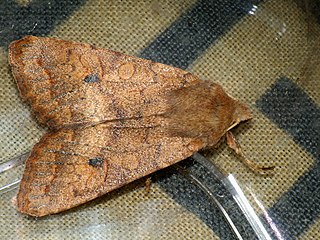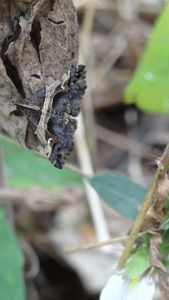
The garden dart is a moth of the family Noctuidae. It is distributed throughout much of the Palearctic. Temperate regions of Europe, Central Asia and North Asia, as well as the mountains of North Africa. Absent from polar regions, on Iceland and some Mediterranean islands, as well as in Macaronesia.

Agrochola circellaris, or The Brick, is a species of moth of the family Noctuidae. The species was first described by Johann Siegfried Hufnagel in 1766. It is distributed throughout most of Europe, Asia Minor and Armenia.

Hulodes caranea is a species of moth of the family Erebidae first described by Pieter Cramer in 1780. It is found from India, Sri Lanka, Myanmar, Java, Hong Kong to Queensland and New Guinea, it is also found on the Marianas and Carolines.

Agrochola litura, the brown-spot pinion, is a moth of the family Noctuidae. The species was first described by Carl Linnaeus in 1761. It is found in Europe and the Middle East. It is possibly also present in North Africa, but this is unclear because similar looking species Agrochola meridionalis is found there.

Xanthorhoe decoloraria, the red carpet, is a moth of the family Geometridae. The species was first described by Eugenius Johann Christoph Esper in 1806 and it is found in northern Europe, to the east across the Palearctic to Siberia and the north of North America; further south it seems to occur chiefly, if not exclusively, in the mountains.

Apamea lateritia, the scarce brindle, is a moth of the family Noctuidae. It is found in much of the Palearctic. It is a sporadic migrant in Great Britain, where it is recorded from the east and south-east coasts.

Hexadactilia trilobata is a moth of the family Pterophoridae described by Thomas Bainbrigge Fletcher in 1910. It is found in Australia in Queensland and New Guinea.

Hellinsia tinctus is a moth of the family Pterophoridae. It is found in Arizona and Mexico.

Bertula abjudicalis is a moth of the family Noctuidae first described by Francis Walker in 1859. It is found in India, Thailand, Laos, Vietnam, Taiwan and from Sri Lanka to Australia, where it has been recorded from New South Wales.
Agonopterix sabulella is a moth in the family Depressariidae. It was described by Walsingham in 1881. It is found in North America, where it has been recorded from Idaho, Alberta and British Columbia and from Washington to Arizona and California.
Ebbepterote is a monotypic moth genus in the family Eupterotidae. It was erected by Rolf G. Oberprieler, Wolfgang A. Nässig and Edward David Edwards in 2003. Its only species, Ebbepterote expansa, was described by Thomas Pennington Lucas in 1891. It is found in Australia, where it has been recorded from Queensland.
Dichomeris habrochitona is a moth in the family Gelechiidae. It was described by Walsingham in 1911. It is found in Panama.
Dichomeris corniculata is a moth in the family Gelechiidae. It was described by Edward Meyrick in 1913. It is found in Assam, India and Guangdong, China.
Ardozyga amblopis is a species of moth in the family Gelechiidae. It was described by Edward Meyrick in 1904. It is found in Australia, where it has been recorded from Western Australia.
Ardozyga phasianis is a species of moth in the family Gelechiidae. It was described by Edward Meyrick in 1904. It is found in Australia, where it has been recorded from New South Wales, Victoria and Tasmania.
Compsotorna oligarchica is a moth in the family Xyloryctidae. It was described by Edward Meyrick in 1890. It is found in Australia, where it has been recorded from New South Wales and Queensland.
Uzucha humeralis is a moth in the family Xyloryctidae. It was described by Francis Walker in 1864. It is found in Australia, where it has been recorded from New South Wales and Queensland.
Lichenaula goniodes is a moth in the family Xyloryctidae. It was described by Turner in 1898. It is found in Australia, where it has been recorded from Queensland.
Hypercallia alexandra is a moth in the family Depressariidae. It was described by Edward Meyrick in 1909. It is found in Peru.
Lethata trochalosticta is a moth in the family Depressariidae. It was described by Lord Walsingham in 1913. It is found in Panama and Costa Rica.








